In 1904, John Moses Browning introduced the .45 Automatic Colt Pistol cartridge for use in his prototype Colt semi-automatic .45 pistol. The resultant pistol was adopted on March 29, 1911 by the United States Army in 1911 as the “Model of 1911.” Many firearm manufactures produced variants of it around the world and those variants that are available to the civilian market are as popular today as ever.
In 2011, Sturm Ruger & Company introduced its first ever 1911 variant – the SR1911. The Ruger SR1911, a full size “Government” model (some call it a “Calvary” model due to its long barrel length) was soon followed by the Ruger SR1911CMD; a shorter-barreled version of the SR1911. Some would call the SR1911CMD the “Commander” or “Artillery” version in deference to Colt’s designations of “Government, Commander, and Officer” series of 1911 pistols.
Ruger’s entries in the 1911-based pistol genre mirrored the functionality of the Government and Commander pistol with the SR1911 being comparable to the Colt Government 70 Series pistols and the SR1911CMD being comparable to the Colt Commander (and Combat Commander) 70 Series. Later, Ruger introduced (in its own way) the SR1911CMD-A, a lightweight, “Commander” length pistol indicative of the Colt “70” Series Lightweight Commander.
The Ruger SR1911CMD, like its predecessor the Colt Commander (or Combat Commander), was to provide a lighter, shorter version of the 1911. However, unlike the original Colt Commander that was chambered for the 9mm cartridge, the Ruger SR1911CMD version is chambered for the .45 ACP cartridge. Also unlike the original Colt Combat Commander, the Ruger SR1911CMD is of stainless steel construction. The Ruger SR1911CMD also has features that were not available at the time of the Colt Combat Commander; features that have now been accepted as “normal” by modern standards. If the Ruger SR1911CMD had been available at the time, it would have been carried as my off-duty piece instead of the Colt. I can say the same about the Ruger SR1911 over the Colt MK IV “80” Series that I carried as a LEO.
I have owned a version of the Ruger SR1911CMD since June of 2013. I actually bought the Ruger SR1911CMD a day before I purchased the SR1911. Two years later, in 2015, I purchased the SR1911CMD-A. All three pistols have proven their worth as fine examples of a 1911-based pistol that is affordable yet exhibits the quality and features of pistols more their asking price by other manufactures. While I have opined on the SR1911 (https://guntoters.com/blog/2016/01/08/ruger-sr1911-model-no-6700/) and SR1911CMD-A (https://guntoters.com/blog/2015/08/25/rugers-sr1911cmd-a-is-an-a-winner/), I had yet to express my opinion on the SR1911CMD – the all steel version of the SR1911CMD-A. But, now I close out all reviews on the Ruger SR1911 series of pistols with the review that follows.
CLASSIC STYLING:
The original 1911 Series “70” design provides for easy take-down and re-assembly. The SR1911CMD has the same slim traditional design as the M1911 and comes with hardwood grip panels and checkered metal mainspring housing. The grip panels are standard .25-inch thick panels and afford a good gripping surface.
MODERN MANUFACTURING:
Precision CNC-controlled machining process results in a superior slide-to-frame fit and smooth slide travel. The 4.25-inch stainless steel barrel and mated bushing are produced from the same bar stock, on the same machine, for improved accuracy.
The slide is forged while the frame is cast using in-house casting resources. While most parts are manufactured in-house, some are manufactured elsewhere, but all are manufactured within the U.S.
PERFORMANCE:
Positive barrel lock-up allows for a superior accuracy out-of-the-box. Over-sized ejection port and extended magazine release enhance performance. As is usual with a new pistol, the SR1911CMD performance has yet to be proven in the long run. With over 100 years of 1911 heritage put into its design, and with modern manufacturing and materials, I would expect the Ruger SR1911 series of pistol to perform far into the future.
TRIGGER AND HAMMER:
Lightweight, aluminum, skeletonized trigger features an adjustable over-travel stop and provides a very crisp, no creep, light trigger pull with a quick, positive reset. Some have claimed that the trigger fit is too loose. I have no problem with the fit and function of the trigger. The SR1911CMD is not, after all, a custom ED Brown. The trigger pull on my particular SR1911CMD is 4.5-pounds and my finger has not told me that it dislikes the trigger. The edge of the trigger indexes into the first joint of my shooting finger (where I prefer one to index), does not “sting” my trigger finger (as have some triggers on polymer wonder guns), and serves the same purpose as does those “hand-fitted” triggers. I can live with that.
The skeletonized hammer is lightweight and provides faster cycling. Pulling the hammer back to the cocked position reveals a substantial hammer spring. The hammer is nicely roiled to provide a good purchase when cocking and de-cocking the pistol.
SIGHTING SYSTEM:
Dovetailed, 3-dot sight system features a Novak® LoMount Carry rear and standard front sight that combines optimal target acquisition in an ideal carry configuration. Some have complained that the sights are too small, but I have no issue with them.
The rear sight is drift-adjustable and is held into the slot with a hex-head screw. On my particular pistol, there was no need for windage adjustments because the sights were spot on. In bright sunlight, and with my old eyes, the sights were easy to pick up. I may; however, in my usual fashion, drop a dot of fluorescent or “glo” red in the front dot well for a bit of contrast.
FRAME AND SLIDE:
 Stainless steel frame and slide feature blasted, low-glare finish and slide serrations for positive grip. The slide-to-frame fit is tight and nicely mated.
Stainless steel frame and slide feature blasted, low-glare finish and slide serrations for positive grip. The slide-to-frame fit is tight and nicely mated.
The plunger tube is also an integral part of the frame and is unlike other 1911’s where the plunger tube is staked to the frame. Although I have never had a plunger tube fail, with the SR1911CMD, SR1911, and SR1911CMD-A that is one issue I don’t have to even concern myself with.
SAFETIES:
The Ruger Sr1911 series of pistols remains true to the original 1911 safeties of the “70” series with a slight twist. The over-sized beaver-tail grip safety provides positive function and reliability. The extended thumb safety and slide stop lever provide for improved, positive manipulation. Although the slide stop, thumb safety and magazine release button are extended, they are not obtrusive to the hand. I found that the beaver-tail safety, as with the SR1911 and SR1911CMD-A, is slightly looser than I prefer it. The beaver-tail safety; however, functions as it should.
In keeping with the 1911 tradition, the thumb safety is mounted on the left side only.
The thumb safety is stiff when new. Some might consider it too stiff, but I would rather have my safety stiff than not. I ride the thumb safety when I shoot, because I would not appreciate it going “on safe” during a string of fire. As a side note, I do like ambidextrous safeties because I try to run a 1911 as much weak hand (left) as I can and an ambidextrous thumb safety is a great feature to have. With that said, I am not going to replace the thumb safety. I can also run a 1911 left-handed and know a few tricks about running the safety weak handed.
An internal safety feature, not found on the original 1911 is the use of a stiff firing pin spring and a lightweight titanium firing pin. This arrangement staved off the need for a (undesired by most) firing pin block since the pistol can be dropped on the hammer and the firing pin will not reach the primer of a chambered round.
MAGAZINES:
The SR1911CMD ships with 2-seven round flush-fitting magazines. While they work well in the SR1911CMD, I have found that they do not work so well in other 1911-based pistols (unless it is the SR1911 or SR1911CMD-A). I have only attributed this to a slightly shorter notch for the magazine release lug as compared to magazines like Wilson Combat and MEG-GAR. While the Ruger magazines would stay locked firmly in place in the magazine well of the Ruger, they had the tendency to suddenly release themselves in non-Ruger 1911-based pistols under firing conditions. However, magazine like Wilson Combat and MEG-GAR work wonderfully in the Ruger SR series of 1911-based pistols. As a result, I use a 7-round flush fit Ruger magazine for carry in the SR1911 series of pistols and have two 8-round Wilson Combat magazines for spares.
INTERNALS:
Internally, the SR1911CMD is well finished to include the feed ramp. Barrel lock-up is assured by more than adequate slots for the locking lugs of the barrel.
The barrel uses the classic JMB swing link design and is almost perfectly mated to the barrel bushing (nothing is perfect). I am not sure why Ruger chose to make the barrel bushing and barrel out of the same bar stock, but it seems to work just dandy. Perhaps, it has something to do with metal expansion rates or something, which is beyond my engineering knowledge. The barrel is throated to reliably feed hollow-point ammunition, and the feed ramp is polished.
Although I would not consider it a safety, which is something that I consider as an item that prevents the pistol from going boom when you don’t want it to, a visual inspection port on top of the chamber allows for visual confirmation that chamber is loaded. This negates the need for performing a “press check” that I have never felt the need to do; if the slide is forward, I consider it loaded until I prove otherwise.
No, Martha! The Ruger SR1911CMD does not have a magazine disconnect safety.
FIELD STRIPPING AND ASSEMBLY:
Disassembly and assembly follow the same procedures as any “True-to-Form” 1911. There are no special tools required and no full-length guide rod. Although Ruger does supply a barrel bushing wrench, I have yet to unpack it.
Unlike the original 1911 pistol, the Ruger SR1911 series of pistols uses hex-head screws to secure the grip panels rather than slotted-head screws.
VISUAL IMPACT:
The SR1911CMD is a very cleanly finished pistol. There are no front serrations or fancy sculpturing and the eight rear serrations are nicely blended into the pistol while providing a good purchase for the hand. All edges are nicely finished.
The front and rear sight, extended magazine release button, slide lock, hammer, thumb safety, beaver-tail grip safety, extractor button, and checkered metal mainspring housing and all pins are black and contrast nicely with the stainless steel frame and slide.
Ruger did a good job in laser-etching the slide and frame with RUGER MADE IN THE USA etched on the left side of the frame and the Ruger “Eagle” etched on the right side of the frame. Some might question the need for “READ INSTRUCTION MANUAL BEFORE USING FIREARM” on the underside of the frame, but at least Ruger did not put it on top of the slide.
The SR1911CMD uses the traditional straight barrel and bushing arrangement and utilizes a standard guide rod and guide rod bushing, which keeps the front end looking clean and mean. I have no intention of changing the guide rod system to a full-length guide rod.
Although the metal mainspring housing is checkered, the front strap is clean of serrations. The Hogue Wraparound grip covers this area and provides my shooting hand with a little more grip area to hold onto; I like a slightly over-size grip area.
The long, aluminum skeletonized trigger is nicely done and has a flat, serrated surface that I like. The edge of the trigger indexes right into the first joint of my shooting finger, which is where I prefer a trigger to be on full-sized handguns. The trigger also incorporates an over-travel stop screw, but blends well with the trigger. The trigger area is also relieved for the trigger finger of either hand.
From the right side, the lowered and flared ejection port provides a nice escape for expended shell casings and extracting and expending shell casings is something that the SR1911CMD does well as Ruger has beefed up the internal extractor for positive extraction.
Like the SR1911, the bead-blasted brushed finish of the pistol makes the SR1911 look classy without looking flashy.
Overall, the SR1911CMD is a clean looking, visually-appealing 1911-based pistol. It has features that would be considered custom in the past but are now considered standard fare. The quality is built in and there should be no doubt about that.
Currently, my Ruger SR1911CMD is outfitted with Hogue Exotic Wood Finger Groove Wraparound grips that, I feel, accent the lines of the SR1911CMD and adds a personal touch. However, and since I intend to carry the SR1911CMD at times, the grip panels will be changed out for a Hogue Wraparound Rubber Grips with Finger Grooves 1911 Colt .45 9mm #C45-000 (see, RESOURCES) and mounted with Hogue Inc Colt Grip Hex head Screws Custom Stainless #45019 (see, RESOURCES) that add contrast to the stainless steel finish of the pistol. I prefer the Hogue rubber wraparound grips to many others when it comes to a handgun that I may have to fight with as my fingers fall right into the finger groves, they add to the girth of the grip area, and (I feel) that I have much more control of the pistol.
HOW IT CARRIES:
If given the choice between a SR1911 and a SR1911CMD, it is a toss-up with me. The SR1911CMD, for all practical purposes, just a shorter barreled version of the SR1911. Given that the butt of the SR1911CMD is the same length as the SR1911, there is virtually no difference in trying to conceal one over the other. The barrel length is what is hidden when carrying IWB and when carried OWB a holster sized to fit the SR1911CMD will, of course, be shorter than with the SR1911. However, a holster sized for the barrel length of a “Government” model pistol perfectly protects the SR1911CMD.
The weight difference between the SR1911 and SR1911CMD is really a moot point when it comes down to it; they are both heavy pistols and one has to appreciate the advantages of a heavy pistol to carry them. I will have to admit; however, that my waist welcomes carrying the SR1911CMD-A over the SR1911 and SR1911CMD.
I like the grip area to be pulled tightly into my side regardless if I am carrying IWB or OWB and, so far, a modified SHTF Gear ACE-1 Gen 2 Holster (http://www.shtfgear.com/) that has substantial Kydex to protect the 4.25-inch barreled Ruger SR1911CMD has met my expectations for IWB carry. The holster is modified in that the sweat guard has been removed and I have added a little more forward cant to the holster to keep the butt of the pistol forward, which helps to blend the full-size grip of the SR1911CMD (or any pistol for that matter) into my side. For OWB carry, a fine holster from Leather Creek Holsters fits the bill, and it was made locally by a local master leather smith. Of course, the holster choice for the 1911-based pistol is wide and varied and is a personal choice, but it must be a good choice.
To accommodate the weight of the SR1911CMD pistol and also two spare 8-round magazines of 230-grain hollow point ammunition, I also wear suspenders. This is, of course, a personal choice.
To carry the SR1911CMD IWB, it also means that I wear a t-shirt to prevent the butt of the pistol from rubbing against bare skin and from getting moisture during the hot summer months of the South from getting to the pistol (regardless of what I am carrying at the time). Some folks welcome the sweat shield on most IWB holsters, as it does what it means. However, and especially with a 1911-based pistol, I don’t want any possible interference with the operation of the thumb safety or my thumb getting to it during the draw stroke. I normally position the thumb on the shooting hand above the thumb safety during the actual draw stroke. When the gun is in the proper firing position, and I am ready to fire, the thumb safety is pushed off-safe. When I am holstering the pistol, the thumb of my shooting hand is below the thumb safety and applies pressure to it during holstering until the pistol is completely holstered. A sweat shield would interfere with this operation.
RANGE TIME:
I actually shot the SR1911 before I shot the SR1911CMD, even though the SR1911CMD was purchased just slightly ahead of the SR1911. When I did finally get around to shooting the SR1911CMD, I didn’t really expect it to shoot better or worse than the SR1911. Aside from a hair more muzzle flip and recoil, the SR1911CMD was on par with the SR1911.
I have always enjoyed the “Commander” 1911-based pistols. To me, the “Commander” 1911-based pistol has a better feel and balance to it over the “Government” model. While the “Government” model may have a slight advantage in the sight-radius department over a “Commander” 1911, at combat distances the sights don’t matter as much as shooting to point of aim. All three Ruger SR1911s do that very well.
I admit that I have not put a lot of rounds downrange with the Ruger SR1911CMD pistol. It is not that I don’t like it or that I don’t want to. I have just had other pistols to shoot, evaluate and carry and I do have an advantage of carrying what I own and want to carry for the most part.
The first ranges session resulted with one-hundred rounds of 230-grain ball ammo going downrange without a hitch with Ruger and other manufacturer’s magazines. At 10-yards distance, the X-ring of a standard silhouette target was successfully removed while standing, unsupported in a modified Weaver stance. That is good enough “Combat Accuracy” for me. At ten yards, simply plant the sight at the top of the X-ring and go for it. If you do your part, the POI will follow.
SUMMARY:
I have written my fair share of reviews on 1911-based pistols; most of which I own and some that I do not own. Comparably, the Ruger SR1911 has exceeded what expectations there was of it in my mind. This is Rugers first ever attempt in the ever-expanding 1911-based pistol field and Ruger is doing it exceptionally well, I think. I also think that John Browning would have been proud of how Ruger brought his design into the modern age.
As one person said, the Ruger SR1911 series has everything you need in a 1911 and nothing that you don’t. I could not say it any better myself.
When the Ruger SR1911 first came out they were priced so that you and I could afford one. They still are, even though prices are creeping up. They are highly popular, entirely made in the U.S. of America, and they are in demand. There are many 1911-based pistols to choose from, but the SR1911, SR1911CMD, and SR1911CMD-A are mine – and I like that!
The SR-1911CMD is a straight up and down old design, but this still-effective platform has been wonderfully done, and the sum of these parts is an elegant, practical pistol that gives you a lot for your dollar.
RESOURCES:
- Ruger SR1911CMD (6702): http://ruger.com/products/sr1911/specSheets/6702.html
- Video review by Hichock45: https://www.youtube.com/watch?v=RnPlJFJ_3hY
- Video review by Hickcokl45 (Chapter 2): https://www.youtube.com/watch?v=d4z6K7yqohc
- Hogue Wraparound Rubber Grips with Finger Grooves 1911 Colt .45 9mm #C45-000: http://www.amazon.com/Hogue-Wraparound-Rubber-Grooves-C45-000/dp/B00VQJFICY/ref=sr_1_1?ie=UTF8&qid=1451408878&sr=8-1&keywords=Hogue+Wraparound+Rubber+Grips+with+Finger+Grooves+1911+Colt+.45+9mm+%23C45-000
- Hogue Wraparound Rubber Grips with Finger Grooves 1911 Colt .45 9mm #C45-000 Review: https://guntoters.com/blog/2016/01/08/hogue-wraparound-rubber-grips-with-finger-grooves-1911-colt-45-9mm-c45-000/
- Hogue Inc Colt Grip Hex head Screws Custom Stainless #45019: http://www.amazon.com/Hogue-Screws-Custom-Stainless-45019/dp/B0010XDK2Q/ref=sr_1_1?ie=UTF8&qid=1451408933&sr=8-1&keywords=Hogue+Inc+Colt+Grip+Hex+head+Screws+Custom+Stainless+%2345019
![]()


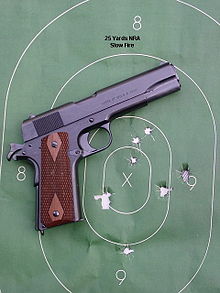

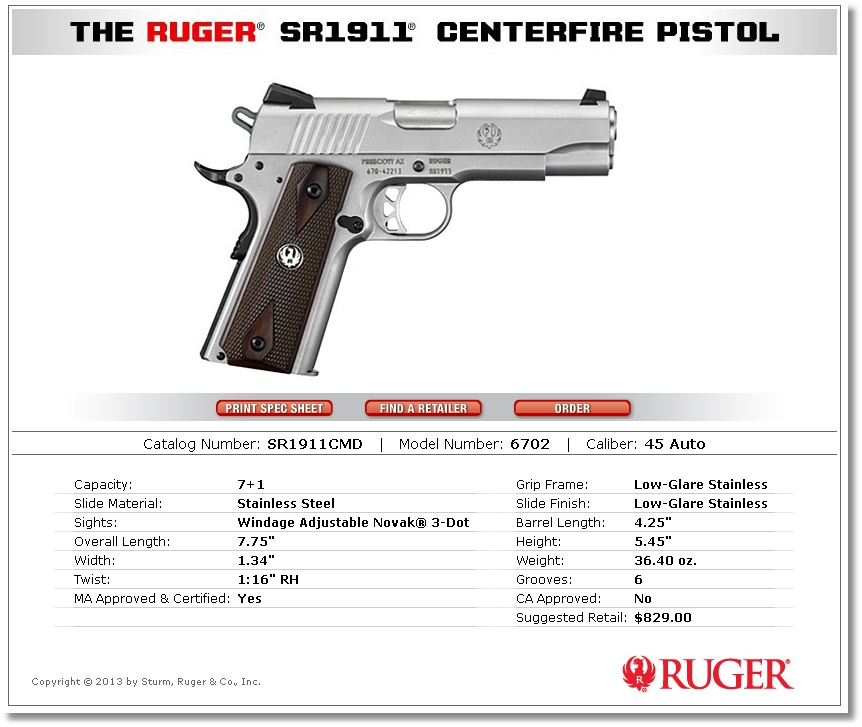
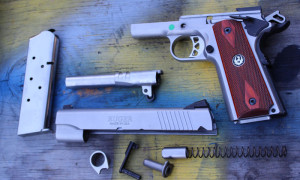
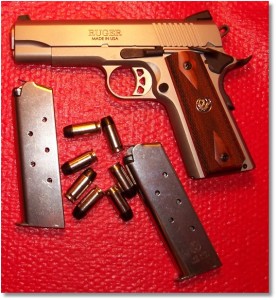

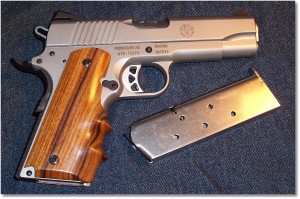
Pingback: Ruger SR1911CMD vs. SR1911CMD-A for CC | Gun Toters